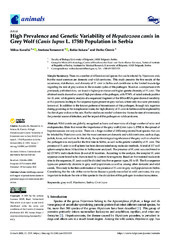Приказ основних података о документу
High Prevalence and Genetic Variability of Hepatozoon canis in Grey Wolf (Canis lupus L. 1758) Population in Serbia
| dc.creator | Kuručki, Milica | |
| dc.creator | Tomanović, Snežana | |
| dc.creator | Sukara, Ratko | |
| dc.creator | Ćirović, Duško | |
| dc.date.accessioned | 2023-08-14T09:15:52Z | |
| dc.date.available | 2023-08-14T09:15:52Z | |
| dc.date.issued | 2022 | |
| dc.identifier.issn | 2076-2615 | |
| dc.identifier.uri | http://rimi.imi.bg.ac.rs/handle/123456789/1334 | |
| dc.description.abstract | Wild canids are globally recognised as hosts and reservoirs of a large number of ecto- and endoparasites. Data that reveal the importance of the grey wolf (Canis lupus L.1758) in the spread of hepatozoonosis are very scarce. There are a large number of different potential host species that can be infected by Hepatozoon canis, but the most common are domestic and wild carnivores, such as dogs, jackals, foxes, and wolves. In this study, the epidemiological significance of the grey wolf as a host for the pathogen was analysed for the first time in Serbia, as well as the genetic variability of H. canis. The presence of H. canis in wolf spleens has been demonstrated using molecular methods. A total of 107 wolf spleen samples from 30 localities in Serbia were analysed. The presence of H. canis was confirmed in 62 (57.94%) individuals from 26 out of 30 localities. According to the analysis, the sampled H. canis sequences were found to be characterised by a certain heterogeneity. Based on five mutated nucleotide sites in the sequences, H. canis could be divided into five sequence types, S1 to S5. The five sequence types can potentially circulate in grey wolf populations as well as among other domestic and wild canids. This study is the first confirmation of the presence of H. canis in grey wolf populations in Serbia. Considering that the role of this vector-borne disease is poorly researched in wild carnivores, it is very important to indicate the role of this species in the circulation of this pathogen in natural ecosystems. | |
| dc.language | en | |
| dc.publisher | Multidisciplinary Digital Publishing Institute (MDPI) | |
| dc.relation | info:eu-repo/grantAgreement/MESTD/inst-2020/200178/RS// | |
| dc.relation | info:eu-repo/grantAgreement/MESTD/inst-2020/200015/RS// | |
| dc.rights | openAccess | |
| dc.rights.uri | https://creativecommons.org/licenses/by/4.0/ | |
| dc.source | Animals | |
| dc.source | Animals | |
| dc.subject | grey wolf | |
| dc.subject | Serbia | |
| dc.subject | Hepatozoon | |
| dc.subject | Serbia | |
| dc.subject | Canis lupus | |
| dc.title | High Prevalence and Genetic Variability of Hepatozoon canis in Grey Wolf (Canis lupus L. 1758) Population in Serbia | |
| dc.type | article | en |
| dc.rights.license | BY | |
| dc.citation.issue | 23 | |
| dc.citation.spage | 3335 | |
| dc.citation.volume | 12 | |
| dc.identifier.doi | 10.3390/ani12233335 | |
| dc.identifier.fulltext | http://rimi.imi.bg.ac.rs/bitstream/id/3053/High_prevalence_and_genetics_variability_of_Hepatozoon_pub_2022.pdf | |
| dc.type.version | publishedVersion |

